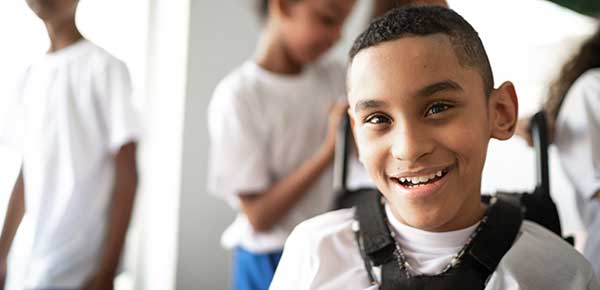October 18, 2018
We all know that when we educate students in social-emotional learning (SEL), they do better academically and are far less likely to engage in risky behaviors. They are also more likely to achieve success in their careers and families down the road.
But in addition to social-emotional education, some of our students need extra, more intensive mental health support to achieve success in both school and life.
All too often, these two keys to student success get lumped together. Mental health and social-emotional learning—it’s all the same, right? The fact is, this couldn’t be further from the truth.
In this blog, I’ll take a look at the key differences between SEL and mental health, and I’ll explain why embracing a whole child mindset is the best way to deal with the ever-growing mental health crisis that today’s students are experiencing.
The current (and rapidly increasing) mental health crisis in our schools
In a recent survey published by the National Association of Elementary School Principals, principals in K–8 schools say their top concern is the rising number of students with emotional problems and mental health needs.
To put it in perspective, this survey has been conducted since 1928. In the 2008 report—just 10 years ago—students’ social-emotional needs did not rank among the top 10 student issues about which the majority of principals expressed “high” or “extreme” concern. Clearly, something has changed in the minds of school principals.

Distinguishing between SEL and mental health
Alongside student emotional and mental health concerns is the recent focus on social-emotional learning (SEL). There is significant confusion around the differences and similarities between student mental health services and SEL programming, and some people have even started to use the terms interchangeably.
There is a clear comorbidity of SEL competencies and student mental health issues, with many students having needs in both domains. However, there are students with clinically diagnosable mental health conditions who do not have identified SEL competency deficits—as well as students with specific social skill deficits that do not have emotional or mental health needs.
There is a common assumption that SEL programming directly addresses the mental health and emotional needs of students, which is only partially true. Students with mental health needs (and all students, for that matter) can greatly benefit from SEL programming, but it may not be a sufficient condition to meet the specific needs of students struggling with mental health conditions.
What does SEL encompass?
The Collaborative for Academic, Social, and Emotional Learning (CASEL) defines SEL as the fostering of social and emotional competencies through explicit instruction and through student-centered learning approaches that help students engage in the learning process and develop analytical, communication, and collaborative skills.
The key word in this definition is “competencies.” Competencies are skills that can be taught and learned through proper pedagogy and science-to-practice methodologies. Social-emotional learning, in many respects, is not an entirely new concept. As far back as 30 years ago, school mental health professionals taught “social skills,” which for all intents and purposes is an analog to SEL.
Social-emotional learning strategies in education center on research that has linked the development of skills like…
- Building healthy peer relationships;
- Responsible decision making;
- Self-management;
- Self-awareness; and
- Social awareness
…to students’ success both inside and outside the classroom.
However, it’s important to make the distinction: social-emotional learning does not encompass mental health conditions such as:
- Post-traumatic stress disorder
- Obsessive-compulsive disorder
- Bipolar disorder
SEL programs can, however, provide strong support for students with diagnosed psychiatric conditions such as attention-deficit hyperactivity disorder (ADHD) and intermittent explosive disorder (IED).
Supporting SEL in schools
Explore SAEBRS, Renaissance’s social-emotional behavior (SEB) assessment suite.
What does mental health encompass?
Student mental health is a primary concern of school and district leaders across the US. According to the National Research Council, the incident rate of mental health concerns in American youth within a given year is estimated to be between 13–20 percent of children. This equates to approximately 10 million students who need professional support in the K–12 public schools across our nation.
For a typical classroom, this would equate to roughly five students having a diagnosable mental health disorder. Stated another way, a typical school of 500 students could have up to 100 students with mental health needs.
Mood disorders such as…
- Depression;
- Anxiety; and
- Bipolar disorder
…are the most common mental health diagnoses among children and adolescents, although the most prevalent parent-reported disorder is attention-deficit hyperactivity disorder.
Many of our students also suffer from:
- Fears
- Phobias
- Performance anxiety
An even greater concern is the suicide rate among youth, which can result from the interaction of mood disorders and other factors, and is the second leading cause of death among children between 12–17 years of age

The impacts of untreated mental health problems
The impacts of untreated mental health problems on our students are significant and can impact an entire school. Students who are left untreated may experience difficulties with the following:
- Concentrating
- Problem-solving
- Following instructions
- Staying engaged and motivated
- Exhibiting self-control (which can be wrongly attributed to willful disobedience or noncompliance)
Students can also have difficulty regulating their emotions and maintaining friendships, which can lead to a sense of isolation and disconnectedness—once again, the co-morbidity of SEL and mental health. In some cases, students can be so immobilized by fear, depression, or anxiety that they choose to avoid school completely.
Furthermore, mental illness often manifests itself in harmful behaviors that may range from physical aggression and bullying to substance abuse and self-injury, all of which can cause great stress for the student, their classmates, teachers, and school staff.
The need to view social-emotional learning from a mental health perspective
Schools and districts must endeavor to address the needs of children from both a social-emotional learning competency perspective and a mental health perspective. Although there is clear comorbidity between SEL and mental health, each of these domains is distinct and must be addressed on its own terms as they relate to assessment, identification, programming, interventions, and monitoring progress.
Districts must be highly systematic in collecting SEL and mental health data on students. To this end, it is critical that districts have the capabilities to…
- House these data securely;
- Analyze longitudinal trends across the district, schools, and individual students;
- Deploy early warning systems; and
- Triangulate multiple measures of data (e.g., SEL, mental health, attendance, home life, grades, test scores, climate, and bullying)
…to develop a whole child perspective.

How viewing SEL and mental health from a whole child perspective makes all the difference
It is from this whole child perspective that schools will be able to identify the specific needs of all students and deliver the best possible programs, services, and interventions. The whole child perspective takes into account the student’s…
- Social-emotional development;
- Mental health;
- Academic development;
- Cognitive development; and
- Physical health
…to ensure that they are safe, healthy, engaged, supported, and challenged in the educational setting.
When each of these factors is taken into account, educators can get a much clearer picture of the child’s abilities and struggles as a whole, have the data they need to make decisions, and implement child-specific solutions. This holistic view of the child is the answer to effectively addressing the needs of both social-emotional learning and mental health.
Renaissance: Leading the way with a whole child approach to social-emotional learning and mental health
At Renaissance, we understand that when educators have access to data that allows them to view the whole child, students realize profound and lifelong benefits. That’s why we have created resources, products, and solutions to help you see the big picture for each student you teach.
Our unique and comprehensive system offers a single data view of the holistic whole child data picture by combining…
- Academic;
- Social-emotional behavior (SEB);
- Intervention; and
- Qualitative
…data for each student.
Learn more
We also offer professional learning to give you great ideas on how to develop relationships with your students. Connect with an expert to learn more.

